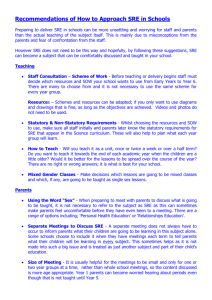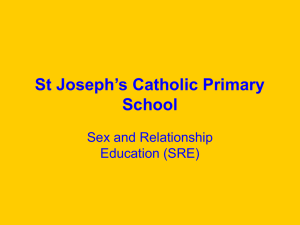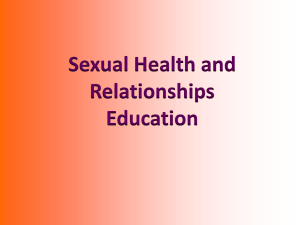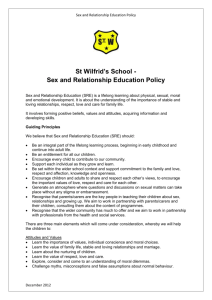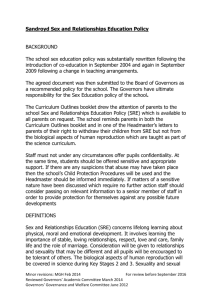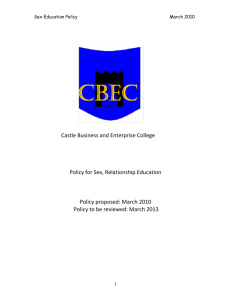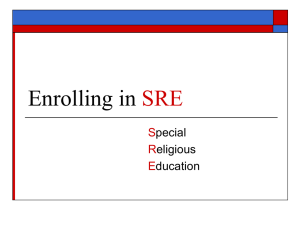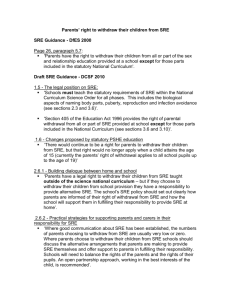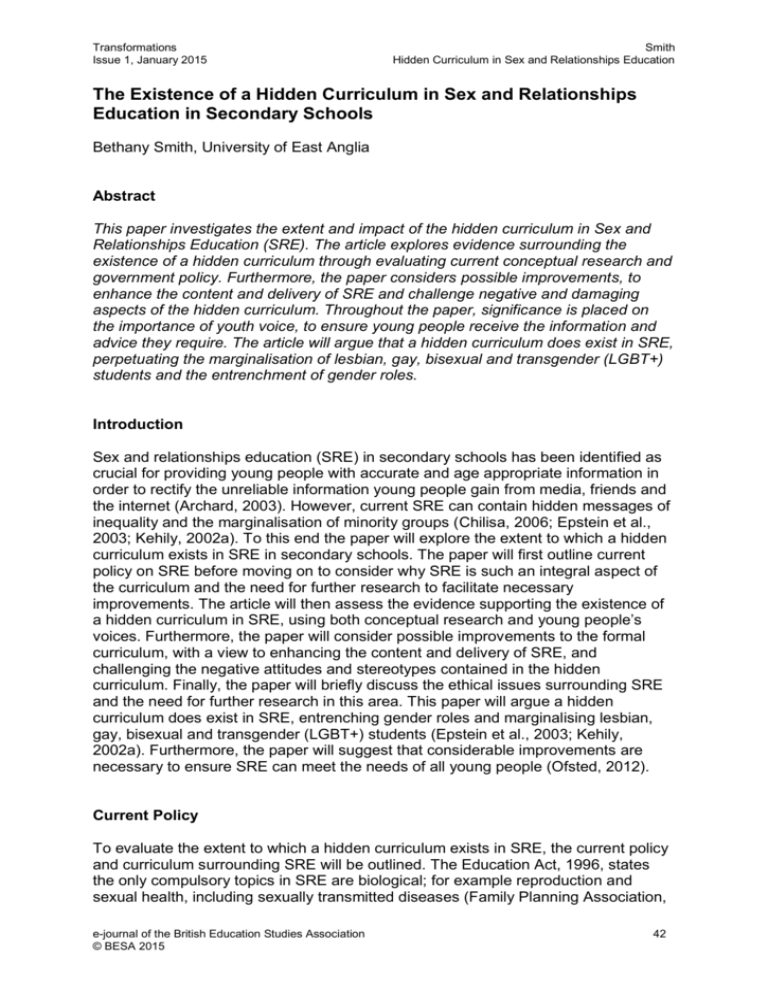
Transformations
Issue 1, January 2015
Smith
Hidden Curriculum in Sex and Relationships Education
The Existence of a Hidden Curriculum in Sex and Relationships
Education in Secondary Schools
Bethany Smith, University of East Anglia
Abstract
This paper investigates the extent and impact of the hidden curriculum in Sex and
Relationships Education (SRE). The article explores evidence surrounding the
existence of a hidden curriculum through evaluating current conceptual research and
government policy. Furthermore, the paper considers possible improvements, to
enhance the content and delivery of SRE and challenge negative and damaging
aspects of the hidden curriculum. Throughout the paper, significance is placed on
the importance of youth voice, to ensure young people receive the information and
advice they require. The article will argue that a hidden curriculum does exist in SRE,
perpetuating the marginalisation of lesbian, gay, bisexual and transgender (LGBT+)
students and the entrenchment of gender roles.
Introduction
Sex and relationships education (SRE) in secondary schools has been identified as
crucial for providing young people with accurate and age appropriate information in
order to rectify the unreliable information young people gain from media, friends and
the internet (Archard, 2003). However, current SRE can contain hidden messages of
inequality and the marginalisation of minority groups (Chilisa, 2006; Epstein et al.,
2003; Kehily, 2002a). To this end the paper will explore the extent to which a hidden
curriculum exists in SRE in secondary schools. The paper will first outline current
policy on SRE before moving on to consider why SRE is such an integral aspect of
the curriculum and the need for further research to facilitate necessary
improvements. The article will then assess the evidence supporting the existence of
a hidden curriculum in SRE, using both conceptual research and young people’s
voices. Furthermore, the paper will consider possible improvements to the formal
curriculum, with a view to enhancing the content and delivery of SRE, and
challenging the negative attitudes and stereotypes contained in the hidden
curriculum. Finally, the paper will briefly discuss the ethical issues surrounding SRE
and the need for further research in this area. This paper will argue a hidden
curriculum does exist in SRE, entrenching gender roles and marginalising lesbian,
gay, bisexual and transgender (LGBT+) students (Epstein et al., 2003; Kehily,
2002a). Furthermore, the paper will suggest that considerable improvements are
necessary to ensure SRE can meet the needs of all young people (Ofsted, 2012).
Current Policy
To evaluate the extent to which a hidden curriculum exists in SRE, the current policy
and curriculum surrounding SRE will be outlined. The Education Act, 1996, states
the only compulsory topics in SRE are biological; for example reproduction and
sexual health, including sexually transmitted diseases (Family Planning Association,
e-journal of the British Education Studies Association
© BESA 2015
42
Transformations
Issue 1, January 2015
Smith
Hidden Curriculum in Sex and Relationships Education
2011). Although further guidance, issued in 2000, advised the inclusion of emotional
aspects of SRE, including relationships, the policy may be socially exclusive due to a
focus upon the importance of marriage as the foundation of a strong family unit
(Hilton, 2009; Formby, 2011). Furthermore, responsibility for SRE remains with head
teachers and governors; consequently schools can ‘opt out’ of having a sex
education programme (DofE, 2000). Therefore, a key problem regarding SRE may
be that it remains a non-statutory subject and, therefore, access can be both unequal
and inconsistent (UK Youth Parliament, 2007). Since 2000, little additional guidance
has been issued; Guidance on Personal Social and Health Education (PSHE),
issued in 2013, defined SRE as an important component of PSHE, however gave
little practical guidance on content, delivery or training (DofE, 2013). It is evident,
therefore, that current SRE topics could be too narrow and inconsistently delivered to
provide all young people with adequate information (Allen, 2005).
Despite a lack of updated policy, SRE could be significant in dispelling any
misleading and inaccurate information young people gain from the media and
internet (Archard, 2003; Epstein, 2003; Formby, 2011; Girl Guiding UK, 2014).
Furthermore, improved, and therefore diverse, SRE could result in students adopting
more tolerant attitudes, which may present a challenge to existing gender
stereotypes and homophobia (Epstein et al., 2003). This is supported by Girl Guiding
UK who advocate SRE is every girl’s right in order to give young women the power
and information to challenge everyday sexism and be critical of gender relations (Girl
Guiding UK, 2014). Moreover, a lack of school sex education could result in young
people gaining information from the media or internet (Archard, 2003). This
information could have a negative influence in shaping young people’s attitudes and
identities due to the invisibility of LGBT+ issues and gender norms being regularly
reinforced (Archard, 2003; Formby, 2011). Furthermore, due to recent government
legislation, schools have an obligation to reduce, and potentially remove,
discrimination on any grounds and therefore SRE should meet the needs of all
students, without any hidden messages of inequality (Equality Act 2006; 2010).
Several key issues have been identified with current SRE, including the limited
content, inconsistent delivery, silence regarding LGBT+ issues and the reproduction
of gender roles (Buck and Parrotta, 2014; Chilisa, 2006; Epstein, 2003; Kehily,
2002b; Ofsted, 2012; UK Youth Parliament, 2007). Moreover, it has been argued
that current ‘sex education is closely tied to sexuality and gender inequalities’, which
could be reinforced through students adopting the attitudes and stereotypes
presented through the hidden curriculum (Chilisa, 2006, 250; Kehily, 2002a).
The Hidden Curriculum
The hidden curriculum can be defined as ‘everything that a learner learns above and
beyond the official or planned curriculum’ (Murphy, Mufti and Kossem, 2009, 164).
This unofficial learning can include behaviours and values transmitted through how
the teaching is delivered (Murphy, Mufti and Kossem, 2009). Moreover, the hidden
curriculum could play a role in reproducing negative beliefs about gender roles
(Skelton and Francis, 2009). For example, reading books may depict males as
actively having careers whilst females, in the role of housewife or mother, are
portrayed as passive (Meigham and Siraj-Blatchford, 2003). In relation to attitudes
towards sexuality and gender roles the hidden curriculum was defined by Epstein,
2003 as:
e-journal of the British Education Studies Association
© BESA 2015
43
Transformations
Issue 1, January 2015
Smith
Hidden Curriculum in Sex and Relationships Education
The attitudes... of students as well as those embedded in the taught
curriculum... inevitably includes the presumption of normative versions of
heterosexuality (Epstein, 2003, 123).
The focus of the paper is on the hidden curriculum. But it will be suggested that in
order to reduce the transmission of negative and less progressive values through the
hidden curriculum, the formal and planned curriculum itself needs to be more diverse
and inclusive.
Methodology
To conduct research into the existence of a hidden curriculum in SRE existing
literature including peer reviewed journals, books and government policy was
reviewed and critically examined. Literature was located and selected using key
word searches including ‘sex education and gender’, ‘sexuality and sex education’
and ‘sex and relationships education’. Due to the contemporary and progressive
nature of the topics being investigated and changes to government policy, literature
published before 1995 was not included. Conceptual literature was investigated
through researching the ideology and content of the hidden curriculum and the
impact of the hidden curriculum on perceptions of gender roles and the concept of
heteronormativity. Finally, conceptual literature was cross referenced with research
on student views and experiences of SRE to support the proposed content of the
hidden curriculum. From this research it became apparent that a hidden curriculum
does exist in SRE. Furthermore, this hidden curriculum could promote heterosexual
relations, marginalise individuals who identify as LGBT+, and perpetuate existing
gender roles and expectations.
Perpetuation of Gender Roles and Stereotypes
SRE can contribute to the embedding of existing gender roles and power dynamics
(Harrison, 2000). In particular, the content of SRE lessons has been identified as a
key factor in reinforcing current power dynamics with males as dominant and
females as passive (Formby, 2011). For example, when discussing sex and
relationships, women are frequently portrayed as passive or submissive and as
wives and mothers. As a result, women are often placed in an inferior position to
men (Measor et al., 2000). Moreover, it has been proposed that the reticence
surrounding female sexual pleasure reinforces the view that women’s needs are
second to, and therefore inferior to, men’s needs (Chilisa, 2006; Formby, 2011;
Strange et al., 2003). This silence is evidenced through the traditional version of sex
being portrayed as the man seeking physical pleasure and the woman as the
provider of pleasure (Harrison, 2000). This depiction could place women in a lower
position with less right to pleasure, consequently supporting traditional power
dynamics (Hirst, 2013). The language used in the depiction of sex, moreover, can
further reinforce traditional gender roles; in some schools sex is portrayed as
‘something done to a woman by a man’ (Skelton and Francis, 2009, 65). As a result,
women’s subservient position may be exacerbated (Skelton and Francis, 2009). In
addition, discussion around other sexual acts, for example oral sex, could further
perpetuate this power dynamic; males are regularly portrayed as the dominant
receiver of oral sex and women as the passive provider of pleasure (Measor et al.,
2000). In addition to the discussion of sexual acts, the silence surrounding women’s
sexual pleasure may be furthered through masturbation being presented as a
e-journal of the British Education Studies Association
© BESA 2015
44
Transformations
Issue 1, January 2015
Smith
Hidden Curriculum in Sex and Relationships Education
distinctly male activity (Measor et al., 2000). As a result, this paper strongly argues
that current SRE reinforces existing power dynamics, evidenced through research
into discussion of sexual acts and the reticence regarding women’s sexual pleasure.
Although sexual acts are frequently discussed in SRE lessons, issues of rape and
consent are rarely examined, suggesting sex is a man’s right and women have no
choice of partner (Buck and Parotta, 2014). Therefore, women’s rights need to be
discussed in SRE, their right, for example, to choose partners and say no (Hilton,
2009). Moreover, it should be noted that this issue is less frequently discussed in
literature surrounding SRE. Consequently it can be tentatively suggested that the
issue of consent may be overlooked in SRE research.
The hidden curriculum in SRE includes not only what is taught, but also the impact
and significance of what is not taught (Kehily, 2002a). A lack of sufficient sex
education may result in young people resorting to pornography for details about
sexual acts. 39 out of 65 students asked said they had used pornography to gain
information about sex (Measor et al., 2000). As viewing pornography can reinforce
gender norms and strengthen the view of women as sexual objects, the lack of detail
in SRE can be linked to the reproduction of gender inequalities and sexist attitudes
(Allen, 2005; Hovarth et al., 2013; Hald et al., 2013). As a result of the expectations
placed on women from the influence of pornography and the media, SRE should
empower young women to resist and challenge these pressures (Buck and Parotta,
2014; Girl Guiding UK, 2014).
A further consideration regarding the hidden curriculum in SRE is the extent to which
classroom conduct reinforces gender stereotypes and the view of women as sexual
objects (Buck and Parotta, 2014). In SRE lessons, frequent instances of boys using
negative and derogatory labels to describe and objectify women are rarely
challenged by teachers (Buck and Parotta, 2014). Males using slang terms to
describe female bodies and sexual organs can create shame surrounding
menstruation and may result in girls feeling ashamed of their bodies (Harrison,
2000). In addition, negative labels and attitudes can diminish girls’ sexual selfconfidence, and could cause them to consider ways in which they might change
themselves to meet male expectations. Therefore, by not challenging the instances
of negative male labelling of women, male dominance may be reaffirmed and gender
power dynamics further reinforced (Kehily, 2002b).
Research on students’ opinions of SRE supports this argument. Young people report
males having the power to label girls purely on their appearance, evidenced through
young girls’ bodies being perceived and criticised from the male perspective,
including being ranked on their relative attractiveness (Measor et al., 2000). This
behaviour can support the idea that femininity is linked to and resides in
attractiveness, thus reinforcing the idea that women should be judged on
appearance rather than ability (Measor et al., 2000). As a result, the attitude that
women should be viewed as sexual objects is reinforced (Kehily, 2002b). Classroom
behaviour could be a central element of the hidden curriculum in SRE, potentially
confirming existing gender norms and power dynamics.
Teacher expectations can also perpetuate gender expectations (Mellor and Epstein,
2006). For example, teachers often classify boys as active or disruptive, whereas
girls are viewed as quiet or calm (Mellor and Epstein, 2006).This distinction can
e-journal of the British Education Studies Association
© BESA 2015
45
Transformations
Issue 1, January 2015
Smith
Hidden Curriculum in Sex and Relationships Education
reinforce traditional power dynamics, male as dominant and women as subservient
(Mellor and Epstein, 2006). Moreover, teachers’ perceptions of girls as innocent and
boys as having desires might strengthen the concept of sex as a principally male
activity pursued for male pleasure (Buck and Parotta, 2014). As a result both student
and teacher expectations and labels could contribute to the reinforcement of existing
power dynamics.
Exclusion of LGBT+ issues and individuals
The first section of the paper has discussed the existence of a hidden curriculum in
SRE in relation to the perpetuation of gender norms and stereotypes. The paper will
now move on to evaluate to what extent heteronormative attitudes result in LGBT+
issues being excluded.
There is a presumption and normalisation of heterosexuality in both government
policy and practice (Kehily, 2002b; Halstead and Reiss, 2003). For example, the
Learning and Skills Act 2002 states SRE must be presented with ‘due consideration
to the importance of marriage and family life’ (Hilton, 2009, 238). Consequently, SRE
can be exclusively focussed on ‘heterosexually imagined futures’, with little or no
allowance for diversity (Epstein et al., 2033, 53). Silence regarding same sex
relationships could be linked to Section 28 of the Local Government Act 1988 which
states that local governments should not promote homosexual relationships.
Although the act did not apply to schools, this clause may have created anxiety for
teachers regarding how to discuss LGBT+ issues in the classroom (Kehily, 2002a;
Measor, 2000). Despite being repealed in 2000 by the Learning and Skills Act, the
legacy of this section may still discourage teachers from discussing homosexuality
today (Epstein et al., 2003). Government policy might promote the traditional,
heterosexual family (Halstead and Reiss, 2003).
In accordance with government policy, in SRE lessons heterosexuality is often the
dominant culture, through the depiction, for example, of the traditional family as man,
wife and children (Halstead and Reiss, 2003; Formby, 2011). This depiction may not
only be socially exclusive of modern families, but could also reinforce the
normalisation of heterosexuality and therefore the marginalisation of LGBT+
individuals (Halstead and Reiss, 2003). Moreover, through the depiction of
penetrative sex as ‘normal’ or ‘real sex’ and the importance placed on marriage,
heteronormativity may be portrayed as the inevitable or default position (Mellor and
Epstein, 2006). Therefore, SRE can often promote marriage as superior to all other
relationships (Formby, 2011). It has been argued that same sex relationships are
‘demonized and rendered virtually unspeakable’ in SRE lessons and more generally
in schools (Mellor and Epstein, 2006, 383). Furthermore the normalisation of
heteronormative relationships could be further reinforced through teachers in
heterosexual relations discussing their home lives, whereas teachers in same sex
relationships may be less likely to do so (Mellor and Epstein, 2006). Subsequently,
there is strong evidence to suggest a hidden curriculum exists in SRE which
promotes heterosexuality and thus marginalises LGBT+ young people.
As a direct result of the promotion of heterosexual relationships, LGBT+ issues may
be largely excluded from SRE lessons, and the needs of LGBT+ youth neglected
(Allen, 2005; Buck and Parotta, 2014; Measor, 2000). For example, in a small scale
e-journal of the British Education Studies Association
© BESA 2015
46
Transformations
Issue 1, January 2015
Smith
Hidden Curriculum in Sex and Relationships Education
study in 2011, no sexual health information was provided for lesbian or bisexual
female students (Formby, 2011). Moreover, details of LGBT+ centres which could
have provided further information were not released. Subsequently, 26% of students
asked wrongly believed you could not transmit sexual infections in a female samesex relationship (Formby, 2011). Although this was a small scale study and thus not
generalisable, it is supported by a Stonewall survey which found only one in five
students (22 per cent) reported discussing gay people or their relationships in SRE
(Stonewall, 2012). In addition, largely cis-women and cis-men are represented,
potentially, excluding trans-identifying youth (Measor, 2000). This is supported by a
Youth Chances study in which 7,000 young people were questioned and 94% were
found to have learnt nothing about trans issues (Youth Chances, 2014). Therefore,
there is clear evidence to support the absence of information regarding LGBT+
issues in SRE (Formby, 2011, Stonewall, 2012). A fully inclusive curriculum, which
is critical of heteronormativity, could help combat homophobia (Buck and Parotta,
2014; Epstein et al., 2003; Warwick and Aggleton, 2014). Moreover, student views of
SRE demonstrate young people want LGBT+ issues to be included in SRE as they
believe inclusion could reduce homophobia and increase acceptance and peer
support (Allen, 2005; Measor, 2000).
It is evident, therefore, that this paper has highlighted the existence of a hidden
curriculum in SRE regarding the exclusion of LGBT+ issues. The paper will now
briefly discuss the impact of this neglect of LGBT+ needs. The exclusion of LGBT+
issues could create a prevailing homophobic atmosphere (Halstead and Reiss, 2003;
Measor et al., 2000). For example, there may be frequent instances of
unchallenged, homophobic language, particularly in SRE lessons attempting to deal
with LGBT+ issues (Epstein et al., 2003; Kehily, 2002a and 2002b; Ofsted, 2012).
96% of LGBT+ pupils have reported experiencing homophobic language on a
regular basis (Stonewall, 2012). As a result of the homophobia and bullying, LGBT+
individuals can feel alienated and ‘othered’, denied a sense of belonging (Epstein et
al., 2003; Kehily, 2002a; Stonewall, 2012). This isolation is further evidenced through
more than half (54 per cent) of lesbian, gay and bisexual pupils feeling excluded
from friendship groups (Stonewall 2012). Therefore, there is evidence to support the
detrimental impact of the exclusion of LGBT+ issues and the need to challenge
prejudices and homophobia through more inclusive and diverse SRE (Buck and
Parotta, 2014; Epstein et al., 2003).
To this end, the paper has demonstrated the existence of a hidden curriculum in
SRE which reinforces dominant heteronormative attitudes (Mellor and Epstein,
2006). The official content of SRE lessons, teachers and classroom behaviour could
all contribute to reinforcing the damaging values of inequality, sexism and
homophobia through the hidden curriculum (Epstein et al., 2003; Skelton and
Francis, 2009). Despite current messages of inequality, the paper has suggested
SRE should be a safe space to discuss existing societal pressures and values, in
order for young people to have greater awareness of inequalities and the confidence
to challenge prejudices (Girl Guiding UK, 2014; Hilton, 2009; Measor et al., 2000).
However, the paper proposes significant improvements are necessary for
discrimination and inequality to be challenged (Kehily, 2002b; Mellor and Epstein,
2006; Skelton and Francis, 2009).
e-journal of the British Education Studies Association
© BESA 2015
47
Transformations
Issue 1, January 2015
Smith
Hidden Curriculum in Sex and Relationships Education
Improvements to theory and practice
To this end, the next section of the paper will discuss possible improvements to the
formal SRE curriculum for the purpose of challenging less progressive attitudes
currently reinforced through the hidden curriculum. The paper will first consider
theoretical improvements, for example the need for an updated and clear
government policy, then move on to explore more practical issues of training and
content. The section will conclude by exploring best practice and alternate
approaches to SRE, including sex positivity and sexuality education.
In order for significant improvement regarding the practice of SRE, a clear and
updated government policy may be necessary (Measor 2000; Ofsted 2012). This
policy should integrate the views and suggestions of young people in relation to their
experiences and recommendations for SRE, to ensure the updated official
curriculum is both age appropriate and relevant to the needs of young people
(Halstead and Reiss, 2003; Measor et al., 2000).
As previously discussed, there is evidence to suggest LGBT+ issues are currently
excluded from SRE (Kehily, 2002b). A key improvement has been identified as a
clear acceptance of, and support for, homosexual relationships being included in
government policy (Allen, 2005; Blake, 2002; UK Youth Parliament, 2007).
Furthermore, future legislation could take steps to resolve contradictions in current
policy regarding promoting marriage and reproduction, yet not marginalising samesex relationships (Epstein et al., 2003). In addition, although Section 28 has been
repealed, concerns regarding the clause may need to be clearly addressed to reduce
teachers’ anxieties when discussing LGBT+ issues (Epstein et al., 2003; Measor et
al., 2000). Future policies should specifically include the need for discussion
surrounding trans issues in order to ensure SRE meets the needs of all young
people (Blake et al., 2014). Conversely, including discourse on LGBT+ relationships
may increase homophobia, since discussing a sensitive issue can cause
controversies to arise (Halstead and Reiss, 2003). However, research into young
people’s views suggests students support the inclusion of LGBT+ issues and
homophobia in SRE, since this might help dispel negative attitudes (Allen, 2005;
Measor, 2000; UK Youth Parliament, 2007).
In addition to inclusion of LGBT+ issues, there is strong support for new legislation to
ensure SRE is a platform for challenging gender norms and power dynamics
(Epstein et al., 2003; Girl Guiding UK, 2014). In order to facilitate the discussion of
gender relations, SRE could be renamed as Relationships and Sex Education. This
might refocus attention, and teaching time, on relationships, choices and rights
(Hovarth et al., 2013). Therefore, for damaging attitudes perpetuated through the
hidden curriculum in SRE to be challenged, future policies must ensure the
foundations are laid in the official curriculum for gender roles to be examined and
LGBT+ issues to be addressed in SRE lessons.
In addition to increasing the range of topics covered in SRE, so that stereotypes and
prejudices might be challenged, SRE should be a compulsory subject (Hilton, 2009;
UK Youth Parliament, 2007). It could underpin positive attitudes towards acceptance
and diversity. If schools were able opt out of SRE lessons some young people’s
attitudes would remain unchallenged (Measor, 2000; Hilton, 2009). Therefore, rather
than SRE being an addition to the curriculum, students and academics propose that
e-journal of the British Education Studies Association
© BESA 2015
48
Transformations
Issue 1, January 2015
Smith
Hidden Curriculum in Sex and Relationships Education
it should be a statutory subject with its teaching hours increased throughout
secondary education (Allen, 2005).
Regardless of the place of SRE within the curriculum, without effective teacher
training SRE lessons may not improve, as teachers can find discussing sexualities
challenging (Mellor and Epstein, 2006; Ofsted, 2012). In addition, teachers can feel
pressure from the media, fearing they might be accused of sexualising children
(Mellor and Epstein, 2006). It is reported that only 3% of teachers feel adequately
trained to deliver SRE (Martinez and Emmerson, 2008). Regular and comprehensive
training would enable teachers to effectively manage disruptive, homophobic or
sexist behaviour, potentially creating an accepting and supportive atmosphere in
which sensitive issues might be discussed (Epstein, 2003; Halstead, 2003; Ofsted
2012; Potter, 2009), including a variety of relationships and the rights of women
(Allen, 2005; Hilton, 2009; Kehily, 2002b; Measor, 2000). Moreover, in order to
improve young people’s sexual self-esteem, there could be a greater focus on
decreasing shame and embarrassment around sexuality and sexual activity
(Halstead and Reiss, 2003). Therefore, improved training is necessary for a safe
space to be created in which difficult issues can be discussed.
Further to additional teacher training, improved resources may be necessary to
challenge existing stereotypes and damaging attitudes. For example, current
diagrams and pictures used in SRE lessons can display women in almost exclusively
subservient positions (Hirst, 2009). To challenge existing gender stereotypes, and
include LGBT+ issues, new resources are necessary (Hirst, 2009; Harrison, 2000).
Alternate Approaches to SRE
In addition to improved teacher training and updated resources, alternate
approaches to the delivery of SRE could reduce homophobia and create a platform
on which to discuss gender relations. SRE should be centred on teacher-facilitated,
student discussion and interaction, as distinct from a more traditional didactic
teacher led approach (Harrison, 2000). However, there are many suggestions
regarding how best to approach these discussions.
One approach could be moving towards sexuality education, using theories and
literature to enhance young people’s understanding of sexuality. This approach could
result in SRE becoming more inclusive and diverse (Mellor and Epstein, 2006;
Skelton and Francis, 2009) facilitating a challenge to traditional attitudes to LGBT+
issues and gender roles (Epstein et al., 2003). Moreover, discussion surrounding
power dynamics and relationships could be extended to a range of subjects, in order
to make the themes relevant to different aspects of daily life and allow a theoretical
critique of society (Mellor and Epstein, 2006). For example, Samanya drama has
created an SRE programme to explore boundaries, relationships and access to
sexual health advice and support through the use of drama techniques (Sex
Education Forum, 2014b). Moreover, Tender Education Theatre developed a
programme based around the exploration of abuse, consent and rape, topics which
can be omitted from school SRE programmes (Sex Education Forum, 2011). This
programme evaluation reported 90% of students involved felt they had learnt
something from the programme (Sex Education Forum, 2011). There is no doubt that
positive steps to include SRE in the wider curriculum are being taken, but these
e-journal of the British Education Studies Association
© BESA 2015
49
Transformations
Issue 1, January 2015
Smith
Hidden Curriculum in Sex and Relationships Education
projects are largely aimed at Pupil Referral Units, and therefore need to be extended
to all schools if widespread change is to be effected.
In contrast, approaching SRE as a discussion based on pleasure could improve
gender equality and engage LGBT+ students (Hirst, 2013). Through viewing sex as a
potentially pleasurable activity for all genders, the discussion of rights could be
facilitated, as well as discussion about safety and sexual health and the importance
of these issues for all young people (Hirst, 2013). Discussing sex as a pleasurable
activity could result in young people taking greater responsibility for their own sexual
choices and health, through reinforcing safety and choice as a right of all young
people (Hirst, 2013). Although research into alternative approaches to SRE is not
widely developed, it can be tentatively suggested that a combination of discussing
sexuality across the curriculum and adopting a more positive attitude to sex and
sexuality could help to address the inequalities currently reinforced through SRE.
Ethical Considerations
Despite the emergence of new approaches to SRE and support for the introduction
of an updated government policy, potential obstacles to progress have been
identified (Halstead, 2005; Sanjakdar, 2013; Van Dijk and Van Driel, 2007). Religious
values could limit advancements regarding improved SRE, due to conflict over
discussion of sexuality, teaching of homosexuality and challenging gender norms
(Halstead and Reiss, 2003; Smerecnik et al., 2010). For instance, accepting and
teaching sexual differences may be challenging for teachers, causing them to omit
sensitive topics from SRE lessons (Sanjakdar, 2013). Moreover, including LGBT+
issues and challenging gender norms may cause conflict with religious values for
both teachers and pupils (Sanjakdar, 2013).
There is much discussion surrounding how SRE should be taught to Muslim students
without causing conflict with Islamic teachings (Halstead, 2005). As Islamic
teachings have specific attitudes and values regarding marriage and family life,
Muslims may have the right not to encounter the topic of homosexuality in SRE
lessons (Halstead, 1997). However, Muslim LGBT+ youth, friends and peers could
need support, and SRE could be an opportunity to increase awareness and
acceptance and challenge homophobia (Halstead and Reiss, 2003; Van Dijk and
Van Driel, 2007). But it is reported that Muslim youth are reluctant to discuss
sexuality and, therefore, are more likely to not attend compulsory SRE lessons
(Smerecnik et al., 2010). However, some studies suggest that religious groups and
leaders do want to be more involved in the delivery of SRE in schools and, therefore,
potential partnerships could be developed to foster positive relationships and deliver
appropriate, sensitive multi-cultural SRE (Thurrock Council, 2010).
Another potential barrier to compulsory SRE is that academies and free schools are
not obliged to provide SRE in line with the national curriculum (Long, 2014).
However, greater freedom regarding SRE could facilitate the development of a policy
that reflects the school’s values and beliefs through liaising with religious leaders,
parents and students (Sex Education Forum, 2014; Smerecnik et al., 2010). Such a
policy would need to reflect the school’s obligation to the wider inclusion agenda and
secretary of state guidance on SRE, and therefore could not discriminate against any
e-journal of the British Education Studies Association
© BESA 2015
50
Transformations
Issue 1, January 2015
Smith
Hidden Curriculum in Sex and Relationships Education
protected characteristic (Equality Act, 2010; Long, 2014; Sex Education Forum,
2014).
Conclusion
In conclusion, this paper has evaluated the extent, and impact, of the hidden
curriculum in SRE lessons. The paper has demonstrated the frequent normalisation
of heterosexual relationships and the extent to which the needs of LGBT+ individuals
may be overlooked. Furthermore, the paper has suggested that the exclusion of
LGBT+ issues can contribute to the creation of a homophobic atmosphere in
schools, furthered through unchallenged homophobic language and bullying (Epstein
et al., 2003). Moreover, the paper has evaluated the extent to which current SRE
reinforces gender inequalities, considering classroom conduct, language and teacher
expectations (Kehily, 2002b). The paper has concluded that SRE can contribute to
the promotion of existing power dynamics and sexist attitudes through poor
presentation of information and underlying stereotypes (Mellor and Epstein, 2006). In
addition, the paper has considered possible improvements to the official curriculum
in order to challenge less progressive attitudes currently reinforced through the
hidden curriculum. In particular, a clear, diverse and updated government policy,
reflecting the recommendations of academics and young people has been identified
as essential (Allen, 2005; Ofsted, 2012). Throughout the paper, the need for further
research into the area has been indicated, particularly regarding the issues of rape
and consent, ethical considerations and the obligations of academies.
References
Allen, L. (2005) ‘Say Everything’: exploring young people’s suggestions for improving
sexuality education in. Sex Education: Sexuality, Society and Learning, 5 (4), 389404. Available
at: http://www.tandfonline.com/doi/abs/10.1080/14681810500278493#.UxTgiPl_sms
(Accessed: 3rd March 2014)
Archard, D. (2003) Sex Education, in Curren, R. (eds.) A Companion to the
Philosophy of Education. Oxford: Blackwell Publishing. Available
at: http://lib.myilibrary.com/Open.aspx?id=234976&src=0 (Accessed: 14th March
2014)
Blake, S. (2002) Sex and Relationships Education: A step by step guide for teachers.
London: David Fulton Publishers.
Blake, S., Emmerson, L., Lees, J. and Hayman, J. (2014) Sex and relationships
education (SRE) for the 21st century. Available at:
http://www.sexeducationforum.org.uk/media/17706/sreadvice.pdf (Accessed: 15th
December 2014)
Buck, A. and Parrotta, K. (2014) Students teach sex education: introducing
alternative conceptions of sexuality in. Sex Education: Sexuality, Society and
Learning, 14 (1), 67-80. Available
e-journal of the British Education Studies Association
© BESA 2015
51
Transformations
Issue 1, January 2015
Smith
Hidden Curriculum in Sex and Relationships Education
at: http://www.tandfonline.com/doi/abs/10.1080/14681811.2013.830968 (Accessed:
21st February 2014)
Chilisa, B (2006) ‘Sex’ Education: Subjugated discourses and adolescent’s voices in.
Skelton, C., Francis, B. and Smulyan, L. (eds) The SAGE Handbook of Gender and
Education. London: SAGE.
Department for Education (DfE) (2000) Sex and Relationships Education Guidance.
Available at: https://www.gov.uk/government/publications/sex-and-relationshipeducation (Accessed: 3rd March 2014)
Department for Education (DfE) (2013) Guidance: Personal, Social, Health and
Economic Education (PSHE). Available
at: https://www.gov.uk/government/publications/personal-social-health-andeconomic-education-pshe/personal-social-health-and-economic-pshe-education
(Accessed: 14th March 2013)
Epstein, D., O’Flynn, S. and Telford, D. (2003) Silenced sexualities in schools and
universities. Staffordshire: Trenthan Books Ltd.
Equality Act (2006) Available at: http://www.legislation.gov.uk/ukpga/2006/3/contents
(Date Accessed: 28th November 2014)
Equality Act (2010) Available at:
http://www.legislation.gov.uk/ukpga/2010/15/contents (Date Accessed: 28th
November 2014)
Formby, E. (2011) Sex and relationships education, sexual health and lesbian, gay
and bisexual cultures, views from young people in. Sex Education, Sexuality, Society
and Learning, 11 (3), 255-266. Available at: http://shura.shu.ac.uk/3848/ (Accessed:
18th August 2014)
Girl Guiding UK (2014) Improve Sex Education. Available
at: http://girlguiding.org.uk/news/improve_sex_education.aspx?utm_content=buffer2
6166&utm_medium=social&utm_source=twitter.com&utm_campaign=buffer
(Accessed: 2nd September 2014)
FPA (2011) Sex and Relationships Education Factsheet. Available
at: http://www.fpa.org.uk/factsheets/sex-and-relationships-education (Accessed: 3rd
March 2014)
Hald, G.M., Malamuth, N.N. and Lange, T. (2013) Pornography and sexist attitudes
among heterosexuals in. Journal of Communication, 63 (4), 638-660. Available
at: http://onlinelibrary.wiley.com/doi/10.1111/jcom.12037/abstract (Accessed: 18th
August 2014)
Halstead, J.M. (1997) Muslims and Sex Education in. Journal of Moral Education, 26
(3) 317-330. Available at: http://dx.doi.org/10.1080/0305724970260306 (Accessed:
14th March 2014)
e-journal of the British Education Studies Association
© BESA 2015
52
Transformations
Issue 1, January 2015
Smith
Hidden Curriculum in Sex and Relationships Education
Halstead, J.M. (2005) Islam, homophobia and education: a reply to Michael Merry in.
Journal of Moral Education, 34 (1), 37-42. Available
at: http://dx.doi.org/10.1080/03057240500049281 (Accessed: 14th March 2014)
Halstead, J.M. and Reiss, M.J. (2003) Values in Sex Education: From principles to
practice. London: Routledge Falmer.
Harrison, J.K. (2000) Sex Education in Secondary Schools. Buckingham: Open
University Press.
Hilton, G. (2009) Personal, Social and Health education in: Cole, M. (eds) Equality in
the secondary school, promoting good practice across the curriculum. London:
Continuum
Hirst, J. (2013) ‘It’s got to be about enjoying yourself’: young people, sexual pleasure
and sex and relationships education, Sex Education, Sexuality, Society and
Learning, 12 (4), 423-436. Available
at: http://www.tandfonline.com.ueaezproxy.uea.ac.uk:2048/openurl/doi/abs/10.1080/
14681811.2012.747433#.U_HRsvldUms (Accessed: 18th August 2014)
Hovarth, M.A.H., Alys, L., Massey, K., Pina, A., Scally, M. And Adler, J.R. (2013)
Basically...porn is everywhere: a rapid evidence assessment on the effects that
access and exposure to pornography has on children and young people. London:
Office of the children’s commissioner for England. Available
at: http://eprints.mdx.ac.uk/10692 (Accessed: 18th August 2014)
Kehily, M.J. (2002a) Sexing the Subject: Teachers, pedagogies and sex education
in. Sex Education: Sexuality, Society and Learning, 2 (3), 215-231. Available
at: http://www.tandfonline.com/doi/pdf/10.1080/1468181022000025785 (Accessed:
8th March 2014)
Kehily, M.J. (2002b) Sexuality, gender and schooling-shifting agendas in social
learning. London: Routledge Falmer.
Long, R. (2014) Sex and Relationship Education in Schools. Available at:
www.parliament.uk/briefing-papers/SN06103.pdf (Accessed: 28th November 2014)
Martinez, A. and Emmerson, L. (2008) Key findings: Teacher’s survey on sex and
relationships education. Available at:
http://www.ncb.org.uk/media/333329/teachers_survey_on_sex___relationships_edu
cation.pdf (Accessed: 15th December 2014)
Measor, L., Tiffin, C. And Miller, K. (2000) Young People’s Views on Sex Education:
Education, Attitudes and Behaviour. London: Routledge Falmer.
Mellor, D.J. and Epstein, D. (2006) Appropriate behaviour? Sexualities, Schooling
and Hetero-gender in: Skelton, C., Francis, B. and Smulyan, L. (eds) The SAGE
Handbook of Gender and Education. London: SAGE.
e-journal of the British Education Studies Association
© BESA 2015
53
Transformations
Issue 1, January 2015
Smith
Hidden Curriculum in Sex and Relationships Education
Meigham, R. and Siraj-Blatchford, L. (2003) A Sociology of Educating (4th edn).
London: Continuum.
Murphy, L., Mufti, E. and Kossem, D. (2009) Education Studies: An Introduction.
Maidenhead: Open University Press.
OFSTED (2012) Not yet good enough: personal, social, health and economic
education in schools. Available at: http://www.ofsted.gov.uk/resources/not-yet-goodenough-personal-social-health-and-economic-education-schools (Accessed: 3rd
March 2014)
Sanjakdar, F. (2013) Educating for sexual difference? Muslim teachers‘
conversations about homosexuality in. Sex Education: Sexuality, Society and
Learning, 13(1), 16-29. Available
at: http://dx.doi.org/10.1080/14681811.2011.634154 (Accessed: 2nd September
2014)
Sex Education Forum (2011) Tender’s Healthy Relationship Education Project.
Available at: http://www.sexeducationforum.org.uk/practice/sex-relationshipseducation/tender%E2%80%99s-healthy-relationship-education-project.aspx
(Accessed: 15th December 2014)
Sex Education Forum (2014) Faith, Values and SRE. Available at:
http://www.sexeducationforum.org.uk/practice/faith,-values-sre.aspx (Accessed: 15th
December 2014)
Sex Education Forum (2014b) Learning about sexual health services through
Drama. Available at: http://www.sexeducationforum.org.uk/practice/sexrelationships-education/learning-about-sexual-health-services-through-drama.aspx
(Accessed: 15th December 2014)
Skelton, F. And Francis, B. (2009) Feminism and ‘The Schooling Scandal’,
Abingdon: Routledge.
Smerecnik, C., Schaalma, H., Gerjo, K., Meijer, S. and Poelman, J. (2010) An
exploratory study of Muslim adolescents' views on sexuality: Implications for sex
education and prevention in. BMC Public Health, 10:533 Available
at: http://www.biomedcentral.com/1471-2458/10/533 (Accessed: 2nd September
2014)
Stonewall (2012) The School Report: The experiences of gay young people in
Britain’s schools in 2012. Available
at: http://www.stonewall.org.uk/documents/school_report_2012(2).pdf (Accessed: 8th
March 2014)
Strange, V., Oakley, A. and Forrest, S. (2003) Mixed sex or single sex Sex
Education: How would young people like their sex education and why? In. Gender
and Education, 15(2), 201-214. Available at: http://eprints.kingston.ac.uk/4612/
(Accessed: 21st February 2014)
e-journal of the British Education Studies Association
© BESA 2015
54
Transformations
Issue 1, January 2015
Smith
Hidden Curriculum in Sex and Relationships Education
Thurrock Council (2010) Sex and Relationship Education (SRE) Review. Available
at: http://www.ncb.org.uk/media/234790/sex_and_relationship_education_review.pdf
(Accessed: 15th December 2014)
UK Youth Parliament (2007) Sex and Relationships Education: Are you getting it?,
London: UK Youth Parliament. Available at:
http://www.ukyouthparliament.org.uk/wp-content/uploads/AreYouGettingIt.pdf
(Accessed: 3rd March 2014)
Van Dijk, L. and Van Driel, B. (2007) Challenging homophobia: teaching about
sexual diversity. Stoke on Trent: Trentham Books Ltd.
Warwick, I. and Aggleton, P. (2014) Bullying, ‘cussing’ and ‘mucking about’:
complexities in tackling homophobia in three secondary schools in south London, UK
in. Sex Education: Sexuality, Society and Learning, 14(2), 159-173. Available
at: http://www.tandfonline.com.ueaezproxy.uea.ac.uk:2048/doi/full/10.1080/1468181
1.2013.854204#.VAXPBPldUms (Accessed: 2nd September 2014)
Youth Chances (2014) Youth Chances: Summary of first findings of the experiences
of LGBTQ young people in England. Available at: http://www.youthchances.org/wpcontent/uploads/2014/01/YC_REPORT_FirstFindings_2014.pdf (Accessed: 18th
August 2014)
e-journal of the British Education Studies Association
© BESA 2015
55

